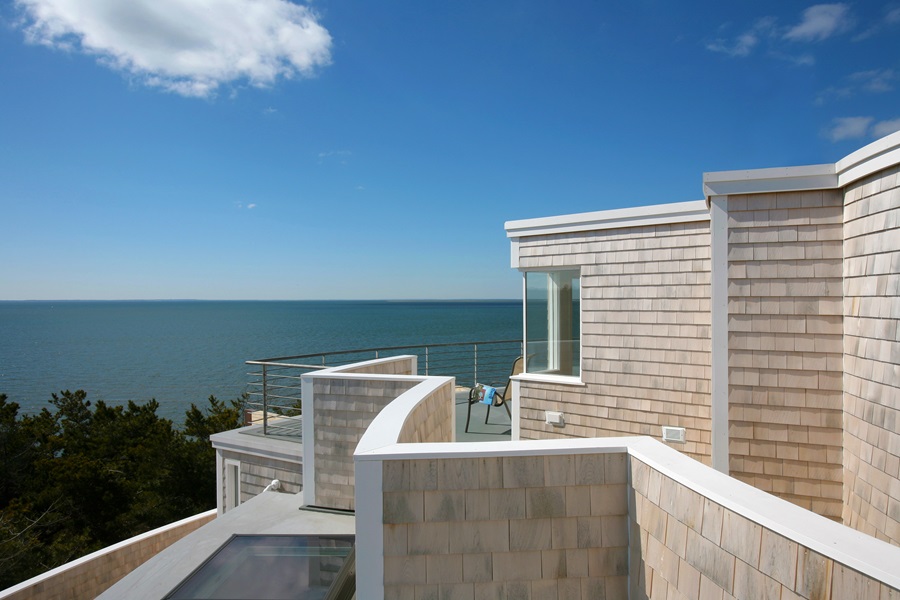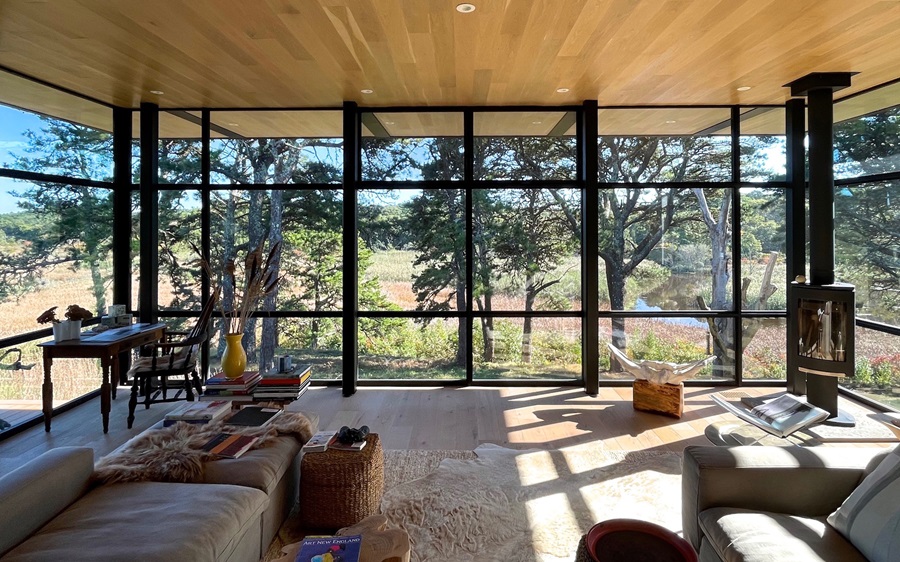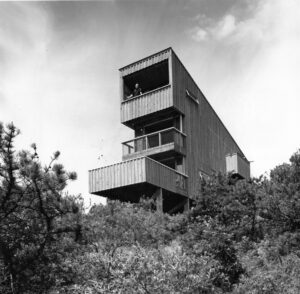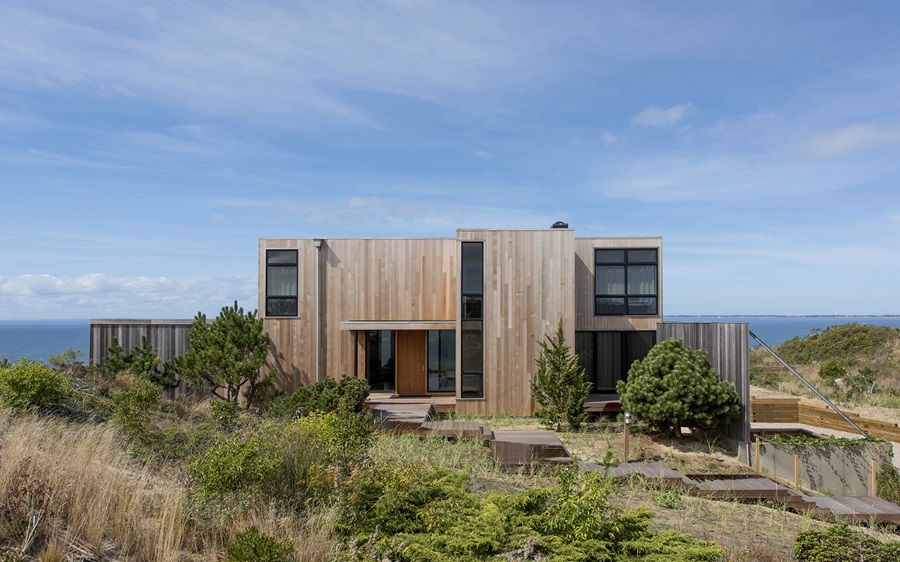Beach houses have evolved since the modernists built their getaways on Outer Cape Cod starting in the late 1930s. But their work is still present in the minds of today’s designers. We asked three architects working here — Paul Krueger, Joy Cuming, and Mark Hammer — to tell us what the words “beach house” mean to them.
Krueger designed his first Outer Cape house in 1966 soon after he served, fresh out of school, as project manager on Harvard’s Carpenter Center — on which Le Corbusier teamed with Josep Lluis Sert. They were looking for someone “without preconceived notions of how things are done,” according to Peter McMahon and Christine Cipriani’s book Cape Cod Modern. Krueger’s Mark house in Truro is a reimagining of Provincetown’s fishermen’s shacks crossed with Le Corbusierian sculpturalism. Only 12 feet wide, floating above a moor on pilings, it is at once a rustic cabin and edgy artwork.
Cuming has been designing and building houses on the Outer Cape for 30 years, starting out with the late Alan Dodge, who had worked with the self-taught midcentury modern builder Charlie Zehnder. Now she has her own firm, Aline Architects Studio in Orleans. “I don’t think so much about style as I do about what I’m relating to, what the site suggests,” says Cuming. “Modernism allows quite a lot of freedom to explore materials and the relationship of a building to its environment.”
In his 20 years working here, Hammer says he has always felt a connection between contemporary design and the modernist experiments that dot our woods. “Our work is very much informed by our forebears who built the modern houses here,” he says of his Cambridge-based Hammer Architects. “We are connected by the desire to build a house that feels like it fits in, and where the sun and wind inform the design.”

Q: Tell us about your own ideal “beach house.”
“I would have to say my ideal is a tent,” says Paul Krueger from the Cambridge office of Krueger Associates. On trips to Wellfleet with his young family in the 1960s, “We always camped at the Audubon sanctuary. It was only gradually that we started to talk about wanting something a little sturdier than those canvas walls.” For him, what’s fundamental is that a beach house provides immediacy with nature.
Joy Cuming also thinks of the seasons she spent living close to the elements — including on a boat in Provincetown Harbor. She has no single mental image of what a beach house should look like; it might be one in a row of little cottages or a freeform space under a curved roof that follows the undulations of the dunes. “Its forms and shapes emerge from the contours of the place,” she says. Whatever its shape, though, “a beach house should be a place where the materials feel at home on the site. The house needs to feel like it’s meant to be there. A house that touches down lightly would be my ideal.”
“I think ‘beach house’ is kind of an odd term for the Outer Cape, since not many houses are right on the beach here,” says Mark Hammer: “ ‘Seaside’ is a better term.” His own house in Truro overlooks a valley, not the water, which, he says, is “everywhere close enough.” Although the houses he builds often include expanses of glass, he says he’s not always trying to capture views: “The ideal is about a connection to nature, and especially about being able to enjoy natural light.”

Q. You’ve all been designing houses on the Outer Cape for many years. How have beach houses evolved?
“There is a real change in the kinds of materials people are looking for,” says Cuming. “They are more aware of the scarcity of materials we once thought were in abundant supply.” The use of heat-treated wood, electric radiant heat, and all the technical details affect the way you build a house, she says.
Kreuger has watched beach houses grow larger and in some way more serious — the cost of materials is part of what has driven a desire for permanence, he says.
Hammer agrees. “Twenty years ago we were able to build more economically, and many projects were simpler,” he says. “But as the cost of construction grew, people began to view building as a bigger project; houses are more solid now.” People expect to be more comfortable, even though that can be at odds with the beach house ideal, for instance when air conditioning replaces designs that catch prevailing breezes.

Q: It sounds as if you all agree beach houses owe more to nature than to trends. But is there something emerging in beach house design that you especially like?
“In some ways, people have a stronger sense of design than they did when I first started working,” says Cuming. “They often try to describe the way they want to feel in their beach house, rather than starting with a list of room names” — a trend she finds both challenging and liberating.
Kreuger sees an interest in groups of smaller structures, each one satisfying a different need. Instead of designing one big house, he’s found himself building collections of cottages that offer spaces for privacy and for gathering, for an artist’s studio, room for guests, a play house for children — “all while keeping to a humanistic scale.”
Cuming says that the tiny-house movement has shaped that interest. “Everyone is fascinated by the tiny house, though most people don’t want to live in them exactly,” she says.
“You think more now about how you’re going to address environmental concerns,” says Hammer. He likes the design challenge of placing windows to maximizes light in winter combined with brise soleil systems. You’ll see in his recent work big, broad overhanging roofs that keep the sun off the glass in summer.

Q: Is there an element of the ideal that should never be lost?
“Natural light is the most important thing,” says Hammer. And a beach house “must be allowed to expand and contract with the seasons, with different orientations through the seasons and the light at different times of day.”
Cuming takes a similar tack: “The wind and the dunes are so austere and also ever-changing here. It’s important that a beach house respond to that,” she says. “You can’t just orient the entire experience of a house straight out to the ocean. You need to find a good feeling in every direction and in the changing light and mood of the day.”
Krueger says for him a beach house should always be made of natural materials like weathered wood and cedar shingles. And alongside the modernist-inspired pursuit of openness and natural light, a beach house that’s right for Outer Cape Cod will also draw on historical forms like those of simple fish shacks that connect new designs with tradition.
Cuming offers one more essential bit of advice rooted in tradition: “There have to be cozy spots and spaces where you can feel sheltered and protected from the vastness and elements.”



